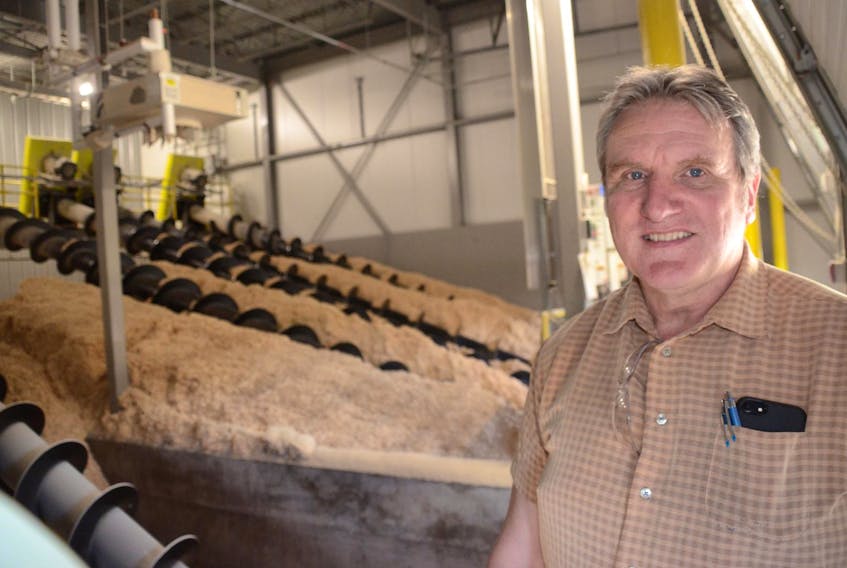The province is planning a large scale conversion of its rural buildings – from schools to hospitals - to heat them with wood.
It will soon release tenders to convert six buildings to biomass heat – most likely in the form of wood chips – with plans to significantly expand the program next year.
“It will be a design, build, maintain type system,” said Lands and Forestry minister Iain Rankin, of the tendering process.
Rankin said the province has a list of 100 buildings that it will consider converting.
The news emerged during an ecological forestry forum held by Rankin’s Department on Tuesday at Dalhousie University’s Agricultural Campus in Bible Hill.
The event brought harvesters, sawmill operators, environmentalists, woodlot owners and pulp mill staff together to hear and respond to the steps being taken to implement an exhaustive study of how forests are managed in Nova Scotia, often dubbed the Lahey Report, after its author University of Kings College president William Lahey.
Higher cost, local spending
Among the report’s 45 recommendations was that the province team up with municipal governments and regional development agencies to create small scale wood energy projects using low quality wood to heat hospitals, schools, government office buildings and correctional facilities.
The report specifically identifies the Western Region of the province for this project.
“It’s a low carbon source and it’s an opportunity for private woodlot owners,” Julie Towers, deputy minister for Lands and Forestry, told the forum.
Eleven government departments have been working on the planned conversion and economists have been brought in from St. Mary’s University to analyse the project.
Rany Ibrahim, director of economic development and trade for Lands and Forestry has been leading the initiative.
Speaking with a focus group held as part of the forum, Ibrahim acknowledged that the upfront cost of wood heat would likely be higher than for oil.
“But when we buy oil, for every dollar we spend eighty cents goes offshore,” said Ibrahim.
“With wood that is reversed, 80 cents of that dollar stays here.”
Global biomass debate

Wood supply and biomass are loaded topics in this province and around the world.
Biomass has been touted as a form of green energy by governments in Europe because trees growing to replace those cut sequester carbon from the atmosphere.
That theory, along with the conversion of numerous coal-powered plants in the United Kingdom to burn wood chips, some of which come from Nova Scotia, all under the banner of green energy have come under broad criticism.
Multiple analyses have shown that the biomass theory doesn’t hold up when forests are cut just to supply energy wood.
Both environmental advocacy organizations and some forestry professionals have railed against Nova Scotia Power’s biomass boiler in Point Tupper as being too large a mouth to feed for this province’s forests while getting significantly less energy out of each tonne of wood fibre than a typical household wood stove.
The facility was sold to the province as being a destination for byproduct from silviculture operations and yard waste from adjacent Port Hawkesbury Paper. However, a 2017 Chronicle Herald investigation showed Port Hawkesbury Paper was cutting old growth forest outside Guysborough to feed the boiler.
Rankin said that these small scale facilities, based on similar boilers in Prince Edward Island, would reach efficiency rates of 90-95 per cent.
And that the province would team up with private woodlot owners and sawmills to supply them.
Northern Pulp shutdown dovetail

The timing of the planned changeover coincides with what is expected to be at least a temporary idling of Northern Pulp in January when the effluent treatment plant it requires to operate at Boat Harbour will be forced to close by provincial legislation.
It remains unclear when the mill’s proposed new effluent treatment plant will be operating as Northern Pulp needs to complete a lengthy list of additional studies before it can get environmental approval to even begin construction.
Sawmill owners and forestry contractors have warned that, without Northern Pulp as a destination for the over one million tonnes of wood fibre it turns into kraft pulp annually, many of them will go bankrupt.
Rankin denied that this is part of the province’s response to the Boat Harbour situation.
“If you look at the scale of the amount of chips Northern Pulp takes you wouldn’t have enough public buildings to even come close,” said Rankin.
“We’re just giving an opportunity for rural woodlot owners to even have a market for this product.”
Inside at the focus session, Ibrahim explained that a small rural school or hospital could consume between 100 to 200 tonnes of wood fibre a year to meet its heating needs. A rough estimate assuming all 100 buildings being considered by the province were converted with an average requirement of 150 tonnes per year would put the consumption at 15,000 tonnes – far short of Northern Pulp’s million tonnes.
The discussion all happened at a campus powered by biomass.
The majority of the 34 buildings on Dalhousie’s Agriculture Campus are both powered and heated by a $26.5 million biomass plant that opened last December.
The one megawatt biomass plant burns 20,000 tonnes of woodchips and sawdust a year, producing about 75 per cent of the electricity requirements of the campus’ 34 buildings.
The steam used to cool the boiler also heats the large majority of those buildings during the winter months.
Three quarters of its wood requirements are supplied by sawmill residue from Irving’s nearby stud mill with the remainder coming from a wide array of sources – including silviculture treatments and waste from a lobster trap-making shop in New Brunswick.
RELATED:









